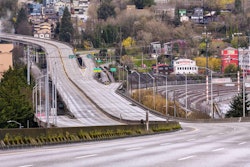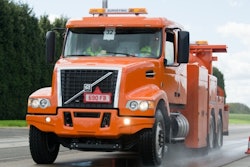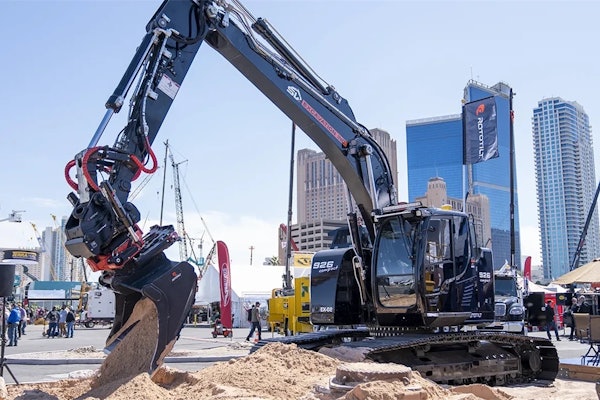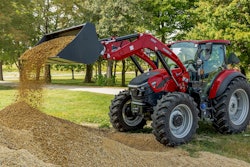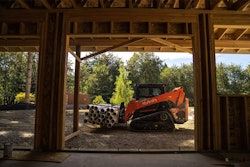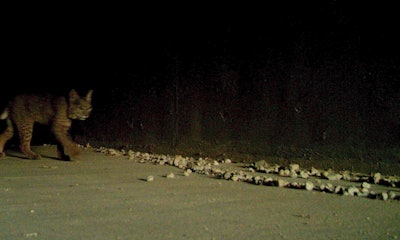
Skanska crews are braving rattlesnakes in the steep mountainous terrain of the Badlands of California, while also saving the deadly snakes, mountain lions and other protected animals that could get killed crossing the highway they are widening.
A full-time biologist has been at the work site for the State Route 60 Truck Lanes project between Moreno Valley and Beaumont in Riverside County to make sure the wildlife in the area, which also includes bobcats and coyotes, are protected.
But the biologst's biggest help to the road crews has been capturing and relocating the rattlesnakes they find out in the brush or seeking shade under the lumber stacks, in the pipes, even underneath vehicles.
"One of our biggest challenges out here is rattlesnakes," says Rafael Gutierrez, Skanska senior project manager. "There's a lot of rattlesnakes. So whenever we were working and our guys come close to a rattlesnake, we call him and he'll grab it and move it away from the project."
That sometimes happens multiple times a day, especially in spring and summer.
Gutierrez says this project is probably his largest in which wildlife plays such a designated role – for both the safety of the animals and for the workers. The area is home not only to the above mentioned animals but more than two dozen protected species, such as badgers, burrowing owls and San Bernardino kangaroo rats.
 A coyote approaches a wildlife crossing on the Route 60 Truck Lanes project.Skanska
A coyote approaches a wildlife crossing on the Route 60 Truck Lanes project.Skanska
The boxed crossings are being built in three phases, allowing traffic to keep moving to and from the neaby desert resorts of the Coachella Valley. The most challenging part are the 26-foot-long mid-sections, where workers are in the median with traffic zooming past on both sides at 30 feet away, Gutierrez says. The excavations are 32 feet deep.
"We were working basically in the median between eastbound and westbound traffic. That's probably the toughest because the excavation was deeper than it was wide," he says. "It's really tough access to get down to the bottom of the boxes."
 The mid-sections of the wildlife tunnels provided the biggest challenge because of their 32-foot-depth, limited space and proximity to traffic.Skanska
The mid-sections of the wildlife tunnels provided the biggest challenge because of their 32-foot-depth, limited space and proximity to traffic.Skanska
"We've seen all kinds of animals here," says Gutierrez. "We've seen a mountain lion; we've seen bobcats, coyotes. There are a lot of possums, smaller stuff like that."
Other wildlife logged by the biologist: bats, deer and red tail hawks. An owl that was hit by a vehicle was rescued and relocated to an owl sanctuary in India.
And, of course, rattlesnakes – red diamond and Southern Pacific species – were relocated. The crews have stayed safe from them. Gutierrez says they receive daily reminders of the danger.
"That's part of our safety topic every morning," he says. "If you're moving material that's been sitting there for a few days, bang on it before you actually go pick it up or just be really careful where you're at."
 "One of our biggest challenges out here is rattlesnakes," says Rafael Gutierrez, Skanska senior project manager.Skanska
"One of our biggest challenges out here is rattlesnakes," says Rafael Gutierrez, Skanska senior project manager.Skanska
Some of the hills were as high as 200 feet, making them too tall for scrapers. Bulldozers were used on those hills first to push the hard-packed silty dirt down to excavators, which loaded the dirt into trucks. The project has involved excavating 2.2 million cubic yards of dirt.
 The steep terrain on the Route 60 Truck Lanes project presented various challenges to road crews.Skanska
The steep terrain on the Route 60 Truck Lanes project presented various challenges to road crews.Skanska
"We want to build something that's useful and meaningful," he says. "We definitely don't want to destroy habitat.
"We want to keep wildlife as wild as we can."
 A closeup of a coyote at a wildlife crossing on the Route 60 Truck Lanes project.Skanska
A closeup of a coyote at a wildlife crossing on the Route 60 Truck Lanes project.Skanska
 The steep terrain on the Route 60 Truck Lanes project provided various challenges for Skanska crews.Skanska
The steep terrain on the Route 60 Truck Lanes project provided various challenges for Skanska crews.Skanska
 A spider excavator comes in handy on the steep hills of California's Badlands.Skanska
A spider excavator comes in handy on the steep hills of California's Badlands.Skanska
 The interior of one of the wildlife tunnels on the Route 60 Truck Lanes project.Skanska
The interior of one of the wildlife tunnels on the Route 60 Truck Lanes project.Skanska






